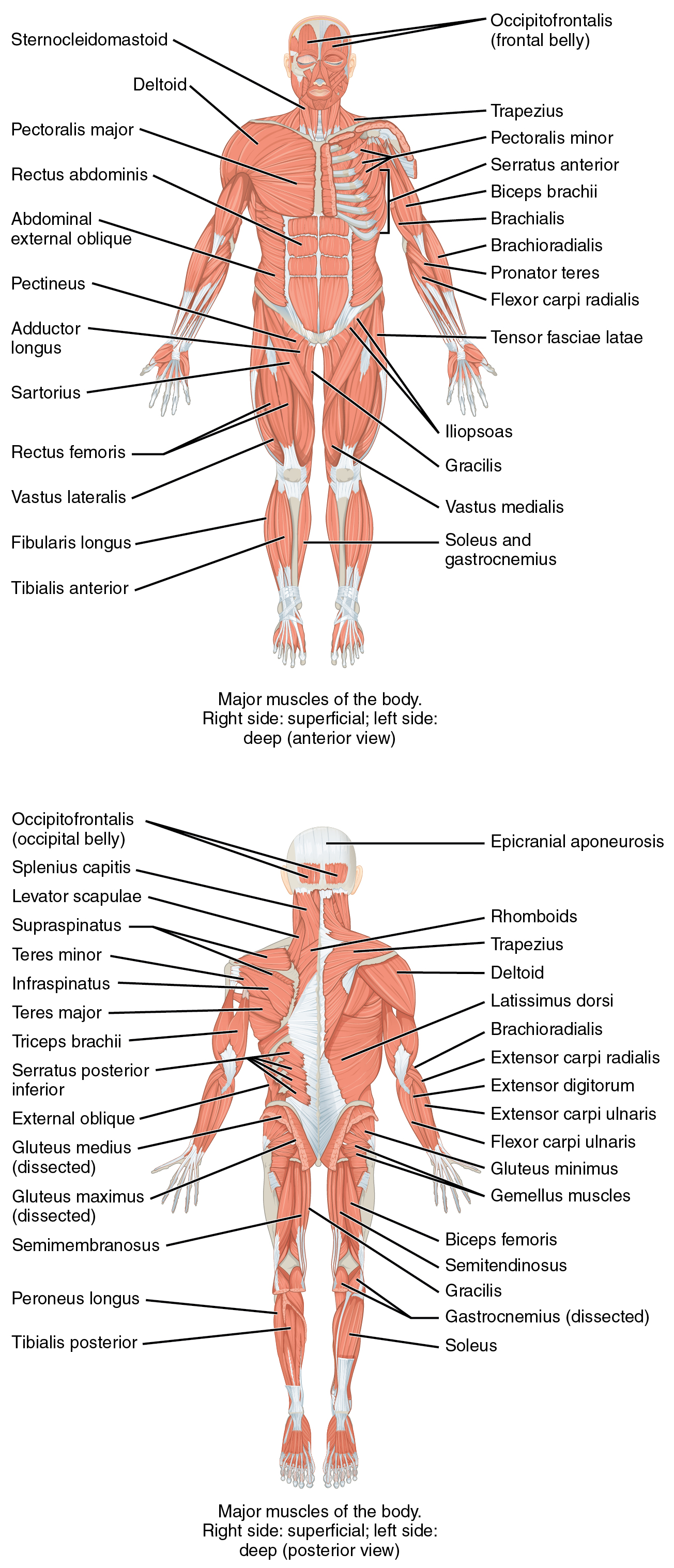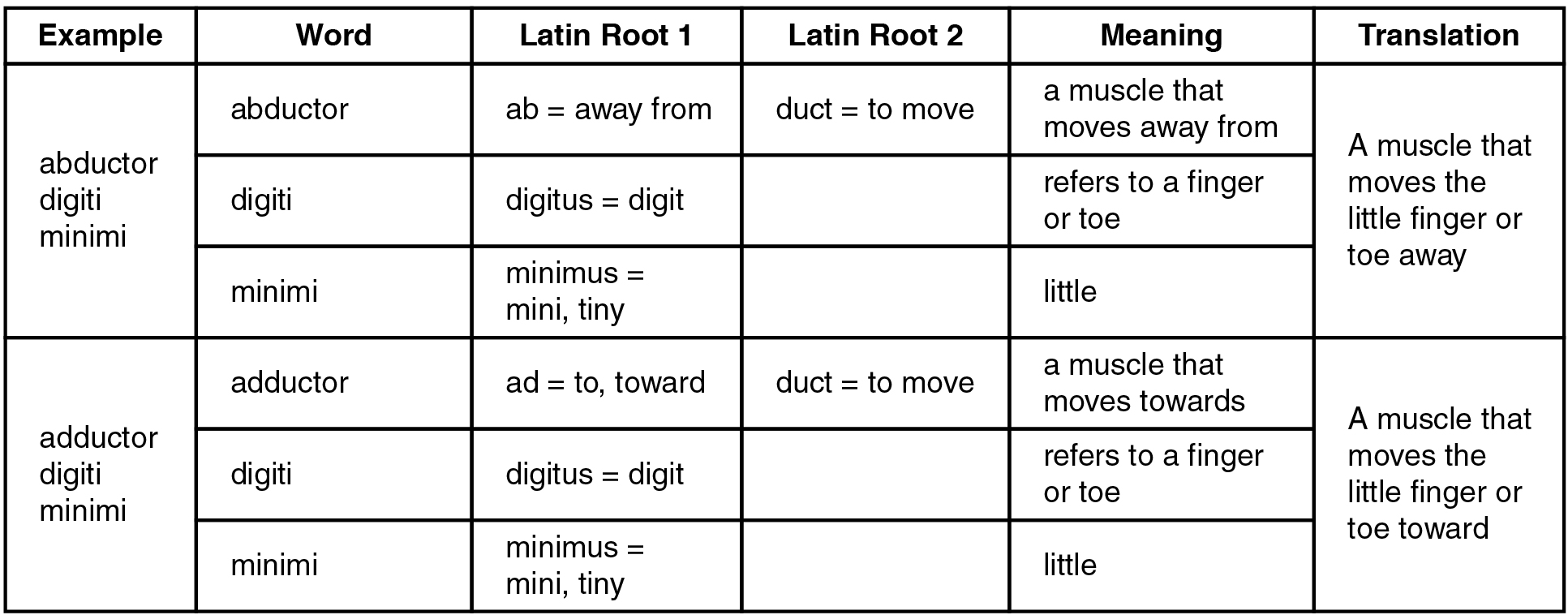Which Of The Following Muscles Is Named For Its Size
The Muscular System
Naming Skeletal Muscles
OpenStaxCollege
Learning Objectives
By the end of this department, you volition exist able to:
- Describe the criteria used to name skeletal muscles
- Explain how understanding the muscle names helps depict shapes, location, and actions of various muscles
The Greeks and Romans conducted the first studies done on the human body in Western culture. The educated class of subsequent societies studied Latin and Greek, and therefore the early pioneers of anatomy continued to utilise Latin and Greek terminology or roots when they named the skeletal muscles. The big number of muscles in the body and unfamiliar words can make learning the names of the muscles in the trunk seem daunting, but understanding the etymology can assistance. Etymology is the study of how the root of a particular discussion entered a language and how the employ of the word evolved over time. Taking the time to learn the root of the words is crucial to understanding the vocabulary of anatomy and physiology. When you sympathise the names of muscles it will help you remember where the muscles are located and what they do ([link], [link], and [link]). Pronunciation of words and terms will take a bit of time to chief, simply after you have some basic information; the right names and pronunciations volition go easier.
Overview of the Muscular System
On the anterior and posterior views of the muscular system higher up, superficial muscles (those at the surface) are shown on the right side of the body while deep muscles (those underneath the superficial muscles) are shown on the left half of the body. For the legs, superficial muscles are shown in the anterior view while the posterior view shows both superficial and deep muscles.

Understanding a Musculus Name from the Latin

| Mnemonic Device for Latin Roots | ||
|---|---|---|
| Example | Latin or Greek Translation | Mnemonic Device |
| advertising | to; toward | ADvance toward your goal |
| ab | abroad from | northward/a |
| sub | under | SUBmarines move under water. |
| ductor | something that moves | A usher makes a train motion. |
| anti | confronting | If yous are antisocial, you lot are against engaging in social activities. |
| epi | on top of | n/a |
| apo | to the side of | n/a |
| longissimus | longest | "Longissimus" is longer than the discussion "long." |
| longus | long | long |
| brevis | short | brief |
| maximus | large | max |
| medius | medium | "Medius" and "medium" both brainstorm with "med." |
| minimus | tiny; little | mini |
| rectus | straight | To RECTify a state of affairs is to straighten it out. |
| multi | many | If something is MULTIcolored, it has many colors. |
| uni | i | A UNIcorn has one horn. |
| bi/di | two | If a ring is DIcast, information technology is made of 2 metals. |
| tri | 3 | TRIple the amount of money is three times equally much. |
| quad | four | QUADruplets are four children built-in at one birth. |
| externus | outside | EXternal |
| internus | within | INternal |
Anatomists name the skeletal muscles co-ordinate to a number of criteria, each of which describes the musculus in some mode. These include naming the muscle after its shape, its size compared to other muscles in the surface area, its location in the body or the location of its attachments to the skeleton, how many origins it has, or its action.
The skeletal muscle's anatomical location or its relationship to a detail bone often determines its name. For case, the frontalis muscle is located on summit of the frontal bone of the skull. Similarly, the shapes of some muscles are very distinctive and the names, such as orbicularis, reflect the shape. For the buttocks, the size of the muscles influences the names: gluteus maximus (largest), gluteus medius (medium), and the gluteus minimus (smallest). Names were given to indicate length—brevis (short), longus (long)—and to identify position relative to the midline: lateralis (to the outside away from the midline), and medialis (toward the midline). The management of the muscle fibers and fascicles are used to describe muscles relative to the midline, such as the rectus (straight) abdominis, or the oblique (at an angle) muscles of the abdomen.
Some musculus names indicate the number of muscles in a group. I example of this is the quadriceps, a group of iv muscles located on the inductive (front end) thigh. Other muscle names can provide information as to how many origins a particular musculus has, such as the biceps brachii. The prefix bi indicates that the musculus has two origins and tri indicates 3 origins.
The location of a muscle's attachment tin besides appear in its proper name. When the name of a musculus is based on the attachments, the origin is ever named outset. For case, the sternocleidomastoid muscle of the neck has a dual origin on the sternum (sterno) and clavicle (cleido), and it inserts on the mastoid procedure of the temporal bone. The last feature past which to proper noun a musculus is its activity. When muscles are named for the motion they produce, one tin find action words in their name. Some examples are flexor (decreases the angle at the joint), extensor (increases the bending at the joint), abductor (moves the bone away from the midline), or adductor (moves the os toward the midline).
Chapter Review
Muscle names are based on many characteristics. The location of a muscle in the body is important. Some muscles are named based on their size and location, such equally the gluteal muscles of the buttocks. Other musculus names tin can signal the location in the body or basic with which the muscle is associated, such as the tibialis anterior. The shapes of some muscles are distinctive; for example, the management of the muscle fibers is used to describe muscles of the body midline. The origin and/or insertion can too be features used to name a muscle; examples are the biceps brachii, triceps brachii, and the pectoralis major.
Review Questions
The location of a muscle's insertion and origin can make up one's mind ________.
- activity
- the force of contraction
- muscle name
- the load a muscle tin can behave
A
Where is the temporalis muscle located?
- on the forehead
- in the cervix
- on the side of the head
- on the chin
C
Which musculus name does not brand sense?
- extensor digitorum
- gluteus minimus
- biceps femoris
- extensor minimus longus
D
Which of the following terms would be used in the name of a musculus that moves the leg away from the body?
- flexor
- adductor
- extensor
- abductor
D
Disquisitional Thinking Questions
Describe the different criteria that contribute to how skeletal muscles are named.
In anatomy and physiology, many word roots are Latin or Greek. Portions, or roots, of the word give us clues nearly the office, shape, activity, or location of a muscle.
Glossary
- abductor
- moves the os away from the midline
- adductor
- moves the os toward the midline
- bi
- ii
- brevis
- curt
- extensor
- musculus that increases the angle at the joint
- flexor
- muscle that decreases the angle at the joint
- lateralis
- to the outside
- longus
- long
- maximus
- largest
- medialis
- to the inside
- medius
- medium
- minimus
- smallest
- oblique
- at an angle
- rectus
- direct
- tri
- three
Which Of The Following Muscles Is Named For Its Size,
Source: https://pressbooks-dev.oer.hawaii.edu/anatomyandphysiology/chapter/naming-skeletal-muscles/
Posted by: fortnerstoult.blogspot.com


0 Response to "Which Of The Following Muscles Is Named For Its Size"
Post a Comment